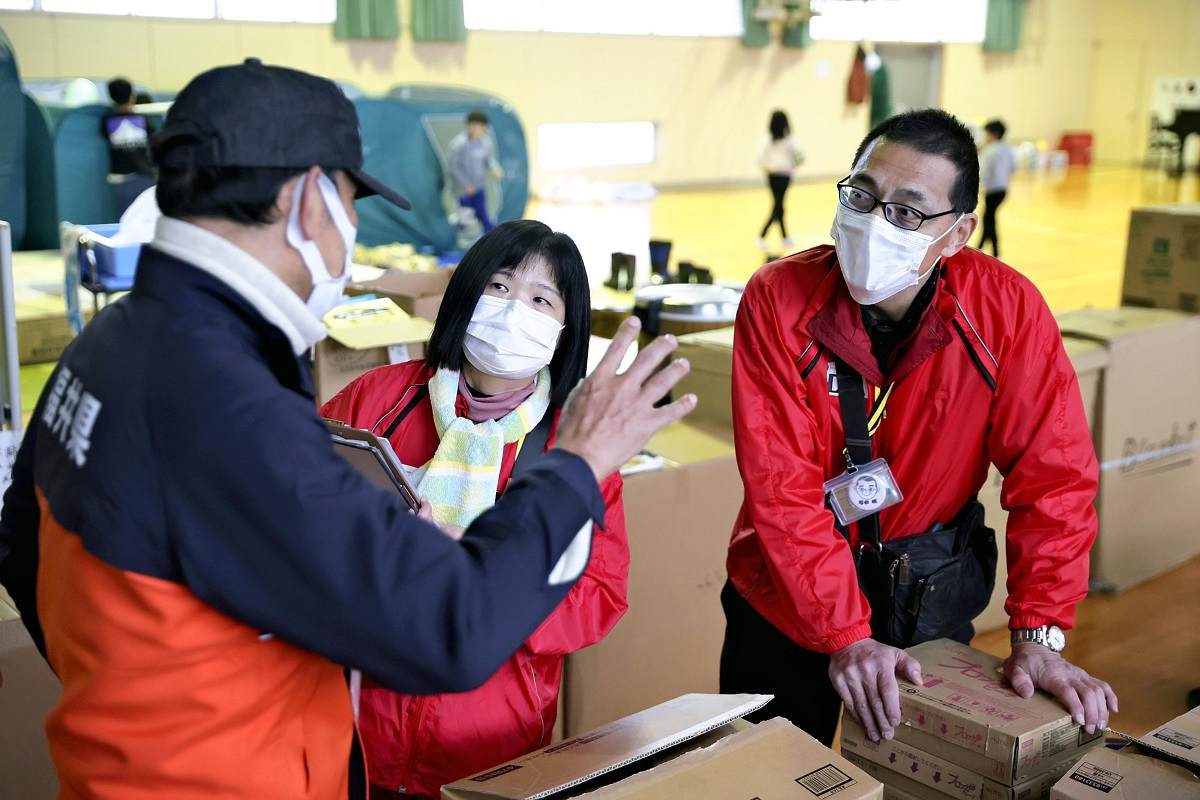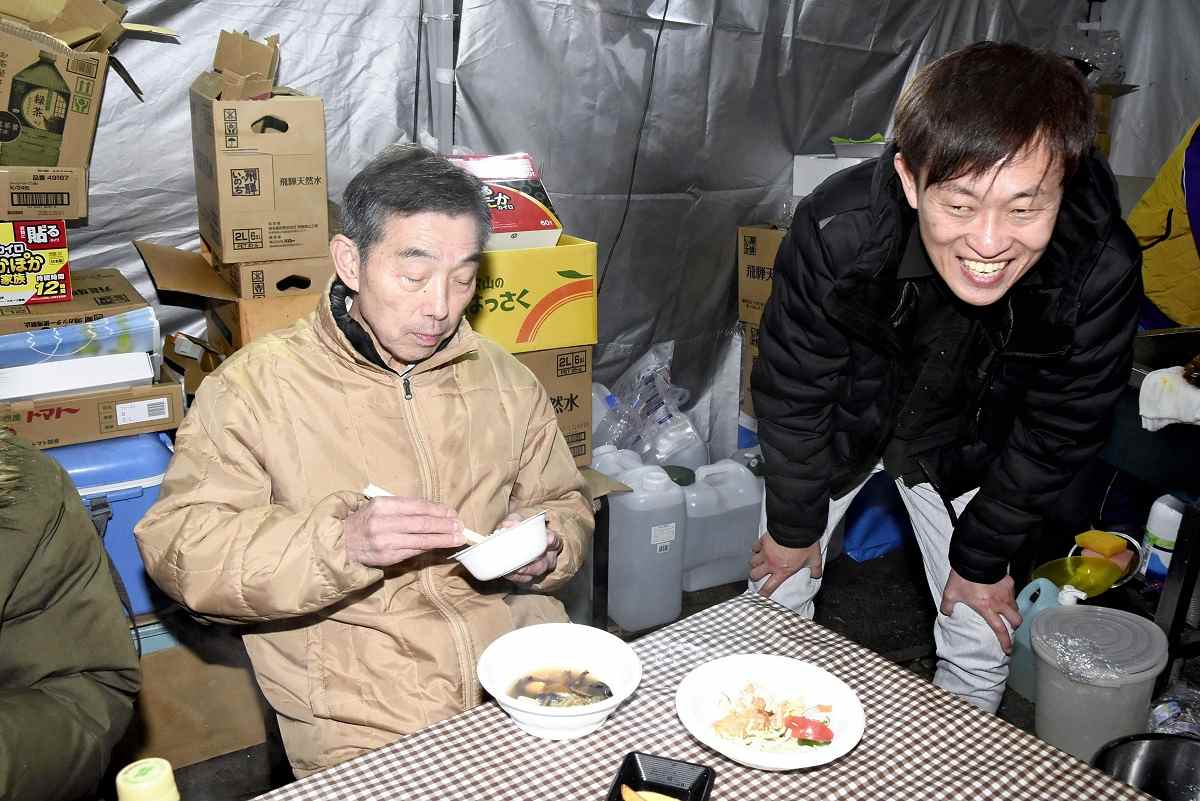Better Nutrition Sought for Japan Quake Evacuees’ Meals; Imbalanced Daily Diet Can Lead to Strokes, Dehydration
Chef Hiroshi Shinde, right, serves hot emergency meals at his restaurant in Anamizu, Ishikawa Prefecture, on Jan. 27.
7:00 JST, February 14, 2024
Local governments are dispatching nutritional specialists to evacuation centers in areas struck by the Noto Peninsula Earthquake, amid concerns that evacuees may become ill if they continue to eat imbalanced meals.
It has been more than a month since the earthquake, but cup noodles and retort-pouch foods are still the main meals at the evacuation center set up at the municipal Shoin Elementary School in Suzu, Ishikawa Prefecture.
Volunteer workers are cooking and serving miso soup and other hot dishes, but a 59-year-old evacuee said with concern: “I’m served very few vegetables. I’m also worried about getting high blood pressure from consuming too much salt.”

Members of The Japan Dietetic Association’s disaster relief team, right and center, listen to a staffer at an evacuation center in Suzu, Ishikawa Prefecture, on Feb. 5.
The city has been dispatching dietitians to local evacuation centers since late January, and a disaster relief team from The Japan Dietetic Association is providing support.
On Feb. 5, two dietitians from the relief team visited the evacuation center at the municipal Wakayama Elementary School to listen to its staff about the three daily meals being served there, how often hot meals are cooked and served, and what nutrients are lacking.
Hearing that some evacuees were drinking all the soup from the cup noodles instead of throwing it away — because the local sewage system had not yet been repaired — the team advised the staff in charge to use less hot water and soup powder. The team also provided the center with such foods as noodles with brown rice, calcium-enriched jelly, and milk that can be stored at room temperature.
“People in the centers have managed to survive the disaster. We want to provide support so they can get the proper nutrition they need to live,” said relief team leader Yoshiyuki Shimoura, 64.
Concerns about dehydration
How does an unbalanced daily diet affect the health of evacuees?
Continuing to eat cup noodles and other high-salt foods can lead to high blood pressure, which combined with the mental stress and disrupted lifestyle during evacuation can lead to life-threatening problems such as a stroke, said Nobuyo Tsuboyama, head of the Section of Global Disaster Nutrition at the National Institutes of Biomedical Innovation, Health and Nutrition.
Tsuboyama also said people get half the water they need daily from food. “If similar unbalanced meals continue, people may lose their appetite, which can lead to dehydration,” she said.
The food served at evacuation centers was also an issue after the 2011 Great East Japan Earthquake.
A team from the institute analyzed the food served at 114 evacuation centers about a month after the 2011 disaster, and found 54 of the locations were providing food with lower amounts of calories, protein and vitamins B1, B2 and C than the guidelines set by the Health, Labor, and Welfare Ministry.
Mouth ulcers and constipation are signs of poor nutrition. “Elderly people are especially susceptible to health problems that can lead to serious conditions,” Tsuboyama said.
‘A source of energy’
Volunteers are working hard to provide nutritionally balanced meals to people forced to continue living at evacuation centers.
About 20 people, including local chefs, have gathered at Noto Bar AZ, an Italian restaurant in Anamizu, Ishikawa Prefecture, since the day after the earthquake to cook and serve free hot emergency meals twice a day. They serve the meals at lunchtime and in the evening, using relief supplies that are arriving from all over Japan.
Noto Bar AZ owner Hiroshi Shinde, 47, said enthusiastically: “A hot meal is a source of energy. The future is still uncertain, but I want to help keep the locals’ enthusiasm for recovery alive.”
Growing interest in ‘emergency evacuation food’
The Noto Peninsula Earthquake has sparked growing interest in “disaster recipes” that can be made even without gas supply and running water, and in “emergency evacuation food” that can be stored for a long time.
Akiko Imajo, a lecturer at Setsunan University and a disaster food specialist, has been posting recipes for cooking ingredients in heat-resistant plastic bags in very hot water since January, putting them on the Faculty of Agriculture’s page on the Cookpad recipe sharing service.
Imajo has posted nine recipes so far, including “chicken rice” made with prewashed rice and tomato juice and “takikomi gohan” made with prewashed rice and dried vegetables.
“I thought of dishes that can be easily prepared on a portable cooking stove,” Imajo said.
Sales of emergency evacuation food in January almost doubled from the same month last year, according to an analysis of data from the point-of-sale (POS) systems of supermarkets nationwide by the Tokyo-based market research firm Merchandising-ON.


